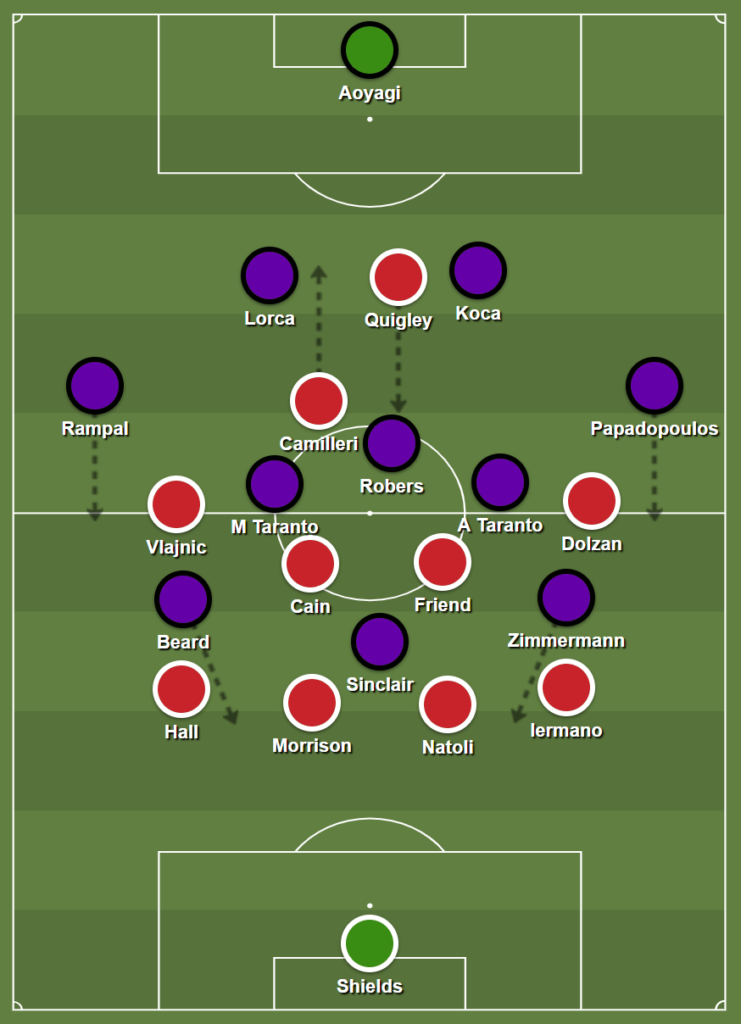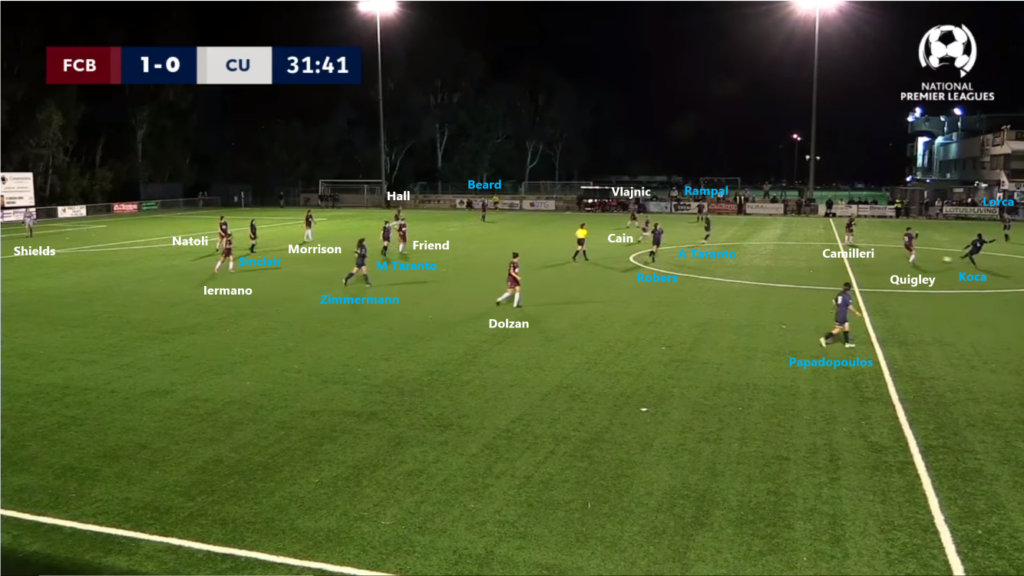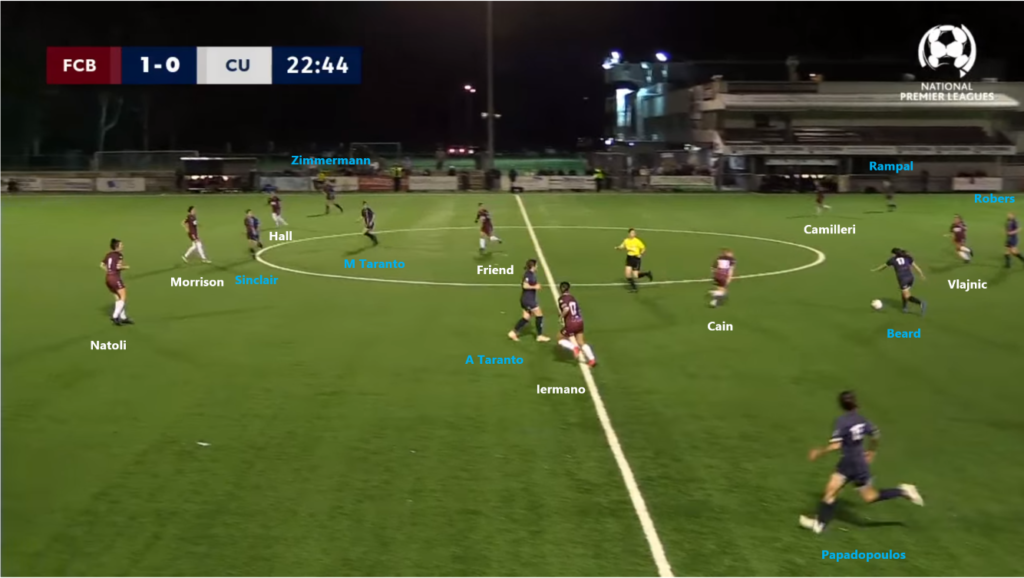Starting lineups

In any game between two teams accustomed to dominating possession, it’s interesting to see how each team adapts to having less of the ball than usual.
FC Bulleen Lions
Bulleen changed to a more conservative system. Fullbacks Kristina Hall and Francesca Iermano rarely went forward, and attacking midfielder Caitlin Friend stood out for her positional discipline in a deeper role next to Sarah Cain to screen the defence. Meanwhile, wingers Tyla Vlajnic and Emily Dolzan dropped deep to help Friend and Cain when Calder attacked. This meant Bulleen’s system was more 4-4-1-1 than their usual 4-3-3.
Furthermore, instead of playing out of the back as usual, Bulleen consistently went long at goal kicks. There was also greater emphasis on set pieces and counterattacks – as exemplified by both their goals.
Calder United
Calder lined up in a 4-3-3 and looked to attack with their usual patterns. The patterns and principles of Calder’s attacking play are consistent whether they use 4-3-3 or a 4-4-2 diamond (as seen against South Melbourne in Round 2). A typical Calder attack starts with their central defenders retaining possession with their central midfielders, giving time for their fullbacks to get into high and wide attacking positions. Meanwhile, their strikers drift in the channels between opposition defenders.
However, with 3v3 in the central midfield zone, Calder struggled to establish stable possession while building up from the back. Consequently, their fullbacks Marie Rampal and Stacey Papadopoulos were hesitant to advance, aware that a loss of possession would leave their central defenders Sarah Lorca and Gulcan Koca exposed. This was how Bulleen scored their second goal – Vlajnic counterattacked into the space behind Rampal, drew Lorca out, and the ball broke to Camilleri to score.
With Rampal and Papadopoulos rarely getting forward, and strikers Catherine Zimmermann, Aleksandra Sinclair, and Angela Beard staying narrow, Calder lacked width and made it easy for Bulleen to defend, as shown below.

Right players, wrong positions
Calder’s width problems were worsened by inverting Zimmermann and Beard – that is, the left-footed Beard on the right wing, and the right-footed Zimmermann on the left. This meant that both tended to drift into central positions, rather than staying wide to stretch the Bulleen defence. Occasionally, Beard and Zimmermann would switch flanks to their “natural” sides, but ended up drifting back into the middle again after finding themselves to be isolated by Bulleen’s block.
Interestingly, while Bulleen’s block was compact horizontally, they left a lot of space between the lines. This meant that Calder were sometimes able to engineer a central overload through Beard/Zimmermann making 4v3, thereby allowing Rampal/Papadopoulos to advance, as shown below.

Interestingly, on the occasions when they did create these overloads, it was usually Papadopoulos who got forward. However, as a right-footer at left back she also tended to come inside onto her stronger foot.
More width, more success
The situation improved in the second half, particularly after Polly Doran came on in the 67th minute, replacing Papadopoulos. This meant Beard shifted to her natural position of left-back, with the right-footed Doran on the right wing. Suddenly, Calder looked much more threatening, with Beard advancing to provide width on the left and Doran staying wide on the right.
Calder’s new emphasis on width stretched Bulleen’s defence, creating pockets of space for their midfielders to exploit. This was how Calder scored, with Mel Taranto getting between Iermano and Alex Natoli to win a penalty. Unfortunately however, the tactical shift came too late for Calder to undo the damage of the first half, and Bulleen became more defensive to see out the game.
Conclusion
Bulleen’s success in this game was down to their tactical adaptability. Recognising the risks associated with playing an open, possession-based style against Calder, Bulleen played more conservatively and were rewarded. Calder, on the other hand, were slow to adapt to the situation, only posing a serious goalscoring threat in the second half. With their next opponents Geelong Galaxy expected to be even more conservative, it will be interesting to see if Calder can rectify the tactical issues they experienced here.
If you missed the game, you can catch the replay on the NPL Victoria YouTube channel.
Don’t miss the next analysis, like Tacticology on Facebook for all the latest updates.
